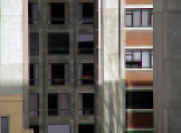| 1 | 2 | 3 | 4 | 5 | 6 | 7 | Samples |
|
So do the results measure up to expectations? |
I did not have very high expectations of DV cameras having long been able to spot their use on many a documentary on the Discovery and National Geographic television channels. Flat, but bright colours and artifacts along edges make footage shot on these little DV cameras stand out a mile. I was hoping that the glass Zeiss-designed lens as well as the very latest in CCD technology would help in overcoming some of this appearance.
The DV image of the PC110 was surprisingly good when I first viewed it via AV output on a modern Sony 21" TV. Easily the best thing I've ever seen off consumer videotape at home. So far so good.
DV has a certain look by default...
I did notice significant edge contrast enhancement and upon further investigation of the DV format, I decided this was due to the compression
and sharpening method used. It works fine for low to medium contrast edges, but high contrast areas are often significantly enhanced in an attempt to make the image appear shaper against a burnt out sky or other light background shows it up quite badly. This is normally done to enhance sharpness and it does generally work, but is not something I've ever enjoyed seeing when it becomes obvious.
Photographers will know this effect from certain developers such as
Agfa Rodinal which does a similar thing with film, though using a vastly
different process of course.
...and it's not up to photographic standards.
I must say that I have had to learn to accept that video equipment has a completely different standard of image quality than we have in conventional photography.
If I were to rate the 'Carl Zeiss' lens by the standards of any stills camera, it would fail miserably. I might say "well, it's very fast and has a massive zoom ratio of 1:10", but would still have to point out the
distortion and the nasty chromatic aberration at pretty much any focal
length and distance.
It should also be mentioned that this lens performs as well as or better
than just about any similar lens on the same sort of camera.
 <click to open> Barrel Distortion at short focal lengths. |
 <click to open> Pincushion distortion at long focal lengths. |
Whilst this lens is possibly (highly likely) better than similar competing items, it is still not really up to much as a photographic objective. There are interesting features. The internal zoom and focus lens sections are moved
(probably) magnetically without any helicoids or barrels with cams cut into them. I'm assuming it's electro-magnetic, but for all I know it could be ultrasound... or even
magic :).
In any case, focus and zoom are 100% silent. When the camera is off, the central group flops around in the camera and has been upsetting some owners of this and also the previous model Sony PC100. It should not cause any damage however.
Manual control possibilities.
The 'manual' focus ring is super smooth (nice grease or perhaps just silky
nylon), but it only works well in the mid zoom range. At the long end it takes far too many turns to operate and to few at the short. In either case,
focusing on an LCD is not a precise operation by any measure. I've found that I do use the infinity lock fairly often and also activate the manual focus setting once in a while to alleviate the sometimes confused and 'searching' auto-focus of its duties.
The focus ring is not mechanically attached to any lens group, it merely
transmits to the electronics that it would like the focus shifted this way
or that.
I should mention that the filter thread is non-rotating and quite solid
into the bargain. It provides some reasonable protection for the
lens mechanics and also won't upset your polarizer adjustment.
When left to its own devices, the auto-focus will often start hunting around and mess up your footage. This happens regularly when something featureless moves across the frame. It's really a trade-off between sensitivity and speed. On the one hand it should not release focus so quickly during a take, but then it also needs to be able to detect sudden changes in distance and go with them. There should really be more than one AF mode in cameras like this.
Zooming is achieved via a very small
sliding tab. This control is progressive and provides for some
extremely fine speed variation, however, it is really too small and does
not have enough throw to enable smooth adjustment during capture.
The result is that no matter how careful you are, you can still always
spot the zoom jerking on and off.
To make matters worse, after a few weeks of use, my one has become a tad
sticky and this make it impossible to begin zooming slowly and
smoothly. I'll be able to deal with this with some minor cleaning,
but it really is a result of the slider's design. It has raised bearing
surfaces to minimize contact area, but in the end, plastic against plastic
just doesn't hack it.
Is the lens sharp?
For this sort of camera it certainly qualifies as sharp. It is definitely contrasty. Especially for
such a high ratio and high speed zoom. It wouldn't make the grade on a film
stills camera though. How people even attempt to judge the sharpness of a lens by using it with a medium
(CCD/DV) that can't even hope to render the sort of detail required is beyond me.
As far as I can see, we can judge lens aberrations, flare and distortion. Sharpness or resolution is just not there to be judged.
It is possible to judge the overall and apparent sharpness of the CCD/lens
combo and I'd rate that as fairly good. The lens is snappy enough to
give an image that seems to impress other reviewers and I'll go with that
too.
I see the aberrations as the greater flaw, however, even then, this camera
would have to rate as one of the better DV Cams around, barring those that
use large and complex lens designs. These tiny zooms with only a
couple of moving components simply cannot give the same high-end
results.... no matter who's name is on it.
That said, video images can be far far worse than photographic images and
still look just fine. I just think it is important to be aware of
the limitations of your own camera. You'd be a fool to copy artwork
with a camera like this, for example.
In the end result, and forgetting all the nastiness I've just mentioned, the lens on the PC110 shows little flare, good contrast and is pretty much the ideal objective for this tiny DV Camera.
If this lens has one real flaw,
it is the lack of a usable wide-angle focal length. The 4.2mm it can manage is
hardly any wider than a typical 50mm 'standard' lens on a 35mm SLR. I will certainly be purchasing a wide angle adapter in the near future. Whether that will be one of the horrendously expensive Sony ones is another matter. I'll be trying the 'high-grade' one out alongside the normal one and will see if either are any good at all.
Those a-focal attachments are notoriously bad, however, we're talking video
here and they are the norm when it comes to altering focal length. Expect an addendum to this report when I've done that.
The 'diaphragm' shape is near-circular (it looks like it might be a
two-bladed affair) and gives quite pleasing out-of-focus areas. Overly bright highlights
typically appear as a vertical stripe which is not very effective, but not always
a total eyesore either.
<added 31 Jan 2001>
Further to the diaphragm: I've just
noticed that the diaphragm does in fact appear to be a conventional
two-bladed one as it is giving me diamond-shaped flare spots in some snaps
I took the other day. The near-round effect I saw initially was really a
result of shooting in low light with a nearly fully-open aperture
mechanism.
| 1 | 2 | 3 | 4 | 5 | 6 | 7 | Samples |